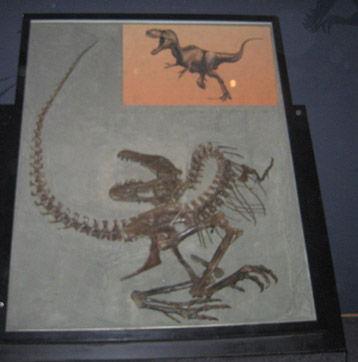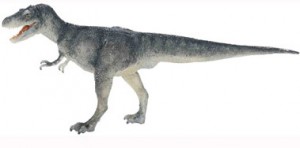Long-limbed Albertosaurs – possible hints at Dinosaur Hunting Habits
Despite their frequent appearance in monster movies the Tyrannosauridae are perhaps not as well known as many people might think, especially when they are faced with the overwhelming number of tyrannosaur exhibits on display at Natural History museums. In truth, even the mighty Tyrannosaurus rex has provided less than 40 fossil specimens for palaeontologists to study and the vast majority of these are far from complete. The popularity of these fierce carnivores is easy to understand, they were certainly impressive beasts but scientists still have a great deal to learn about these animals, their ancestry, social behaviour and morphology.
The likes of Tyrannosaurus rex is synonymous with the Hell Creek Formation of Montana in the north western United States. The exposed strata of sandstone, siltstone and mudstone represent sediment laid down towards the very end of the Cretaceous (late Maastrichtian faunal stage). It was from these beds that the first T. rex fossils were unearthed. However, a greater number of Tyrannosauridae fossils have been recovered from Canada, specifically areas such as the Dinosaur Provincial Park Formation in Alberta. The extensive outcrops of Campanian faunal stage strata from deposits termed the Belly River Group and the Judith River Formation have been dated to approximately 75 million years ago. The Theropod fossils recovered from these sites along with other body and trace fossils have enabled palaeontologists to build up a detailed picture of the eco-system that existed in this area at the end of the Cretaceous. This has led to some speculation as to the hunting habits and specialisation of the tyrannosaurs in this faunal community.
Late Cretaceous tyrannosaurids of Alberta can be classified into two sub-families, the Albertosaurinae and the Tyrannosaurinae (based on research from Phil Currie et al). The albertosaurines from the Dinosaur Provincial Park can be split into two genera, Gorgosaurus and Albertosaurus), the Tyrannosaurinae are represented by Daspletosaurus (D. torosus [Russell 1970], D horneri [Carr et al 2017]). In the 1970s the genus Gorgosaurus was dropped and it was synonymised with Albertosaurus, following a review of existing specimens where no significant characteristics were identified, permitting both genera to be valid. This viewpoint was overturned in 2003 when following a study by a Canadian led team looking at fossils recovered after the review in the early 1970s, several anatomical differences were identified between Albertosaurus and Gorgosaurus and so both taxa were validated. The Gorgosaurus genus was reinstated.
Albertosaurus Exhibit – Royal Tyrrell Museum (Alberta in Canada)

Picture credit: Everything Dinosaur
The photograph shows an almost complete and articulated restoration of an Albertosaurus specimen on display at the Royal Tyrrell museum (Alberta, Canada). The neck and head presented in a curved position over the back and hips is typical of articulated Dinosauria fossils, this effect is believed to occur as ligaments and tendons are desiccated in the carcase and their drying out leads to the head and neck curving over the back of the animal.
The albertosaurs shared their Late Cretaceous world with the likes of Daspletosaurus, (Daspletosaurus means “frightful lizard”). Both these types of tyrannosaur were apex predators, hypercarnivores and at the top of the food chain, however, examination of their fossils reveals that they may have specialised in different hunting strategies and prey.
Albertosaurs had shorter, lower skulls than many other tyrannosaurs. Their leg bones, especially the tibia (shin bone) were proportionately longer than equivalent sized tyrannosaurs. They had longer toes and although the weight of an adult Albertosaurus (A. sarcophagus), has been estimated at 2.5 metric tonnes, these animals were lighter than equivalent sized Tyrannosaurinae.
A 1:40 Scale Model of Albertosaurus (Carnegie Collection Albertosaurus)
Picture credit: Everything Dinosaur
The picture above shows an Albertosaurus dinosaur model, part of the Carnegie Collectibles dinosaur model range (Safari Ltd) which has been retired and is out of production.
To see this model and other tyrannosaurid figures: Visit Everything Dinosaur’s Shop.
The Albertosaurus Genus
It has been speculated that the genus Albertosaurus may represent the fastest large tyrannosaurs around at the end of the Cretaceous. Models and computer simulations have estimated running speeds of up to 25mph (40kmh), this is up to 50% faster than an equivalent member of the sub-family Tyrannosaurinae. Putting this into perspective this long-limbed, long-toed carnivore could complete the 100 metres in around about 10 seconds. Assuming that an Albertosaurus could be given a running start (crossing the start line at approximately full speed), and assuming that this fierce meat-eater did not stop along the way to feast on any athletes, an Albertosaurus could compete for a medal in the sprints at the Beijing Olympics.
Some scientists have speculated that tyrannosaurs began to evolve in different ways, exploiting specific niches within the eco-system. As Albertosaurus was lighter and faster than equivalent sized Tyrannosaurinae, it could have specialised in catching lighter and faster prey types like hadrosaurs, pachycephalosaurs and ornithomimids. Indeed, a diorama of an Albertosaurus chasing a group of ostrich-like dinosaurs greets visitors to the Royal Tyrrell museum. The heavier members of Tyrannosaurinae may have specialised in hunting ceratopsians or possibly titanosaurs.
Lighter and More Gracile Tyrannosaurs
Fossil evidence does indicate that the albertosaurs evolved into lighter and more gracile forms, perhaps indicating that this genus specialised in hunting faster moving animals than the heavier predators.
The fossil evidence is complicated when social behaviour is considered. Albertosaurus bone-beds have been found in Canada. Excavations from Royal Tyrrell museum staff have revealed the remains of at least nine variously sized albertosaurs from one fossil site. Could this be evidence of pack behaviour?
The Safari Carnegie model of Albertosaurus (shown in the picture above) has been designed to replicate much of the latest scientific thinking concerning this particular dinosaur. Working on the guidance of scientists from the Carnegie museum the model has been sculpted to show the long legs and graceful features of this predator. The colouration of the model, muted greys and browns would have make this hunter inconspicuous in shadow and the dappled understorey of woodland. The back, tail and hind quarters of this particular model has darker, stripped markings, again helping to camouflage the animal and break up its outline if it was stalking from cover. In addition, the stripped markings, particularly those on the tail are a concession towards those scientists that speculate that Albertosaurus may have been a social, pack hunter. A group of these animals moving towards a potential group of prey animals at speed would have been a confusing site. Their rapid speed, the dust kicked up and the stripped markings could have disorientated prey, the stripes helping to break up the outline of individual hunters within the pack as they closed in on their unfortunate victims.







Leave A Comment